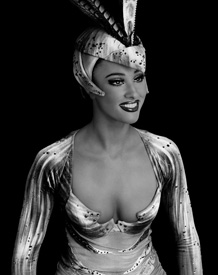
November 07 - January 31, 2009 |
VALERIE BELIN
|
Valérie Belin
|
galerie jerome de noirmont
|

exhibition release
VALÉRIE BELIN – NEW WORKS
November 7, 2008 – January 31, 2009
For her very first exhibition at the gallery (that has been representing her since autumn 2007), from November 7, 2008 to January 31, 2009, at the very time when several European museums are offering her a great retrospective, Valérie Belin will unveil three new series of black and white photographs, marking a real turning point in her approach.
In her first series, Valérie Belin worked only on the luminous spectrum of the objects, on the “drawing” created by the light, by remaining very close to the original process of photography. As in sculpture, this working impression (positive/negative), gave a tangible reality to the predefined identity of subjects. .The appearance of new picture technologies resulted for the artist in a progressive removal from the indexed character of photography to a freer, even more pictorial, treatment of the subject.
In earlier portraits, such as the Mannequins (2003), the spectator was led to question reality, true or false, of the photographed subjects. Nowadays, characters seem to emerge from the virtual sphere. Their existence suddenly seems to be doubted by the image the artist gives us… Valérie Belin’s new portraits no longer pick out a given photographic aesthetic, but as for paintings, they belong to a dreamlike vision, to a specific interpretation of the subject, that of the artist. By giving her the possibility of changing the impression and support technique, of choosing between colour and black and white depending on the effect of the sought-after meaning, the contemporary technological tools led the artist to consider photography over and above its analogical nature, as means of creating a pure image. The characters of her new series are dedicated to the image. They create a picture before us – as the Lido dancer and the magicians, all actors of a show.
The centring and production used for the Lido dancer has a certain similarity with the portraits of mixed-race girls (2006), but in a reversed connection. The photographed girls seemed all the same to us, with very resembling physiques, although all different, wearing similar clothes differentiated mainly by each one’s colour. This time, it is one and the same girl who changes her costume for each picture whilst keeping an identical posture and the same facial expression. By appearing on the portraits with the same professionalism as on stage, the Lido dancer “makes” the picture and shows the evolution of the subject as an “a priori” motive in Valérie Belin’s work. The fantasising of the portrait is strengthened by the demonstrative and demanded duplication effect that makes up this series.
The series of magicians, that also refers to the entertainment world, emphases on the illusory and dramatic characters, as in the cinema. Still in black and white, it shows 5 different characters, shuffling cards. Trying to grasp the illusion, which is not intrinsically photographable, Valérie Belin introduces the movement in the picture; it is this movement that is going to give its illusionary sense to the picture. The dichotomy between the movement of the cards recorded through photography and the static status quo of the character gives the pictures a blatant dramatic character and recalls some symbolic characters from the black Hollywood cinema of the 1950s. The particular light used for the series strengthens the film effect: multiple lighting sources create surfacing rays that form a luminous outline of the silhouettes.
The latest series to date, those of bouquets, reveals much more of this kind of magic realism that characterises the artist’s new works. This series of photographs exudes an aesthetic that makes you think of a dream through its diffused structure, momentum, almost weightlessness. The 5 bunches of flowers, whilst keeping their natural harmony, seem to have been exposed to radiation – or strictly speaking a solarization, which restores them to the immateriality of the negative picture. The transformation of the flowers flesh into quasi-monochrome designs is accentuated by the pictures’ printing technique (inks on paper) chosen for its lack of definition and abnormalities.
ALL WORKS : Edition of 6 copies and 2 artist’s proofs. Unique format.
CATALOGUE : bilingual french / english. Text by Larisa Dryansky. All exhibited works illustrated full-page.
CONTACT: Emmanuelle de Noirmont / Tel : +33 (0)1.42.89.89.00 / Fax : +33 (0)1.42.89.89.03 / info@denoirmont.com









